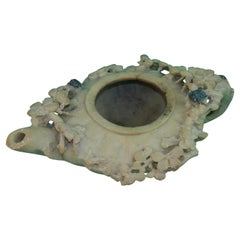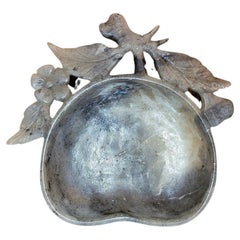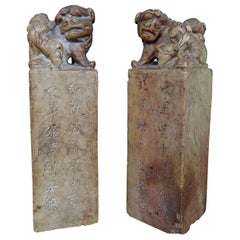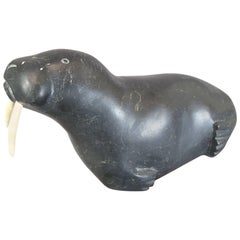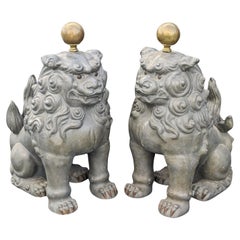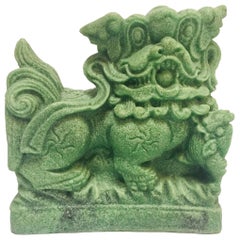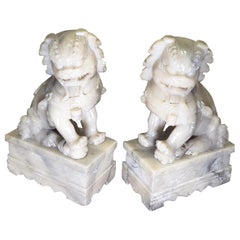Soapstone Sculptures and Carvings
Color: Gray
Material: Soapstone
20C Medium Chinese Soapstone Carving
Located in Dallas, TX
Presenting a lovely 20c medium Chinese soapstone carving.
Made in China in the early 20th century circa 1930.
This is a medium/tall gre...
Category
Early 20th Century Chinese Chinese Export Soapstone Sculptures and Carvings
Materials
Soapstone
Chinese Hand Carved Soap Stone Lantern Incense Censer
Located in Douglas Manor, NY
3-960 Hand carved soapstone incense burner.
Category
1940s Vintage Soapstone Sculptures and Carvings
Materials
Soapstone
20C Chinese Soapstone Polished Ring Dish
Located in Dallas, TX
Presenting a lovely 20C Chinese soapstone polished ring dish.
Made in China in the early 20th century circa 1930.
This is a polished mottled gray soa...
Category
Early 20th Century Chinese Chinese Export Soapstone Sculptures and Carvings
Materials
Soapstone
Pair of Carved Stone Foo Dog Chop Seals
Located in Norwood, NJ
Pair of hard stone chop seals decorated with foo dogs. Two lines of calligraphy across the front. Incised seal on the bottoms.
Category
Late 19th Century Chinese Chinese Export Antique Soapstone Sculptures and Carvings
Materials
Soapstone
Large Inuit Soapstone Sculpture of a Walrus with Tusks by Ragee Kupapik E7837
Located in Ottawa, Ontario
Large Inuit soapstone sculpture of a walrus with tusks, the soapstone is in a large-scale size and quite heavy, the tusks are made from a wal...
Category
Mid-20th Century Canadian Native American Soapstone Sculptures and Carvings
Materials
Soapstone
Large Soapstone Puffin Bird Sculpture, Marked E 5516
Located in Ottawa, Ontario
Large soapstone puffin bird sculpture, simplistic in design, wings tucked in, standing with legs together and the head slightly cocked to one side. The soapstone puffin measures 9&qu...
Category
Mid-20th Century Canadian Native American Soapstone Sculptures and Carvings
Materials
Soapstone
Related Items
Vintage Pair Chinese Pewter Guardian Foo Lions Hong Kong NG AN Signed Mid 20c
Located in Richmond, CA
Pair of vintage Chinese pewter guardian lions, in fierce sitting pose, with copper accents for sharp claws, and each topped with an adjustable height brass ball attached by a threade...
Category
Mid-20th Century Chinese Chinese Export Soapstone Sculptures and Carvings
Materials
Brass, Pewter
Soapstone Hand-Carved Bust of Brahma with Four Faces
Located in North Hollywood, CA
This bust is a beautiful representation of lord Brahma.
Brahma is a part of the holy trinity of Hinduism along with Vishnu the Preserver and Shiva the destroyer.
He is depicted in Hi...
Category
20th Century Thai Folk Art Soapstone Sculptures and Carvings
Materials
Soapstone
Chinese Carved Soap Stone Sculpture of a Wise Ancient with Dragon
Located in Frankfurt am Main, DE
A finely carved soap stone sculpture of a wise ancient with a dragon on his shoulder standing on a braun soap stone base. In fine original conditi...
Category
Early 20th Century Chinese Soapstone Sculptures and Carvings
Materials
Stone
Large Chinese Nephrite Jade Stone Sculpture Hand Carved Fine Art Dragons Statue
Located in Greer, SC
Stunning large Chinese hand carved genuine jade sculpture (tested as nephrite jade) depicting dragons and koi fish. The original owner provided details that this sculpture was create...
Category
Late 19th Century Chinese Qing Antique Soapstone Sculptures and Carvings
Materials
Jade
H 13 in W 30 in D 2.25 in
Monumental Chinese Serpentine Jade Carved Pagoda Censer, Early 20th Century
Located in New York, NY
Monumental Chinese serpentine jade carved pagoda censer, early 20th century.
A masterfully carved Chinese serpentine pagoda censer. The base of the...
Category
Early 20th Century Chinese Qing Soapstone Sculptures and Carvings
Materials
Serpentine
Japanese Vintage Gilt Pheasant Bird Lighting Lantern Censer
Located in South Burlington, VT
Beautiful old vintage gilt pheasant bird lantern and censer
From our recent Japanese acquisitions in original condition with original attractive gilding present.
Japan, an att...
Category
Mid-20th Century Japanese Showa Soapstone Sculptures and Carvings
Materials
Iron
20th Century Chinese Sculpture, Censer in Carved Jade
Located in Casale Monferrato, IT
20th century Beautiful sculpture in precious green jade made in china. Fine censer with carved decorations. The censer rests on a wooden base. Perfect conditions.
Category
1950s Chinese Vintage Soapstone Sculptures and Carvings
Materials
Jade
Antique Chinese Carved Soapstone Spill Vase
Located in Forney, TX
An exceptionally hand-carved antique Chinese soapstone spill vase - spill holder (see below), profusely decorated and intricately detailed naturalistic sc...
Category
20th Century Soapstone Sculptures and Carvings
Materials
Soapstone
A pair of 19th Century carved Foo temple dogs or Chinese guardian Lions
Located in London, GB
Chinese guardian lions, or imperial guardian lions, are a traditional Chinese architectural ornament. Typically made of stone, they are also known as stone lions or shishi (石獅; shíshī). They are known in colloquial English as lion dogs or foo dogs / fu dogs. The concept, which originated and became popular in Chinese Buddhism, features a pair of highly stylized lions—often one male with a ball and one female with a cub—which were thought to protect the building from harmful spiritual influences and harmful people that might be a threat. Used in imperial Chinese palaces and tombs, the lions subsequently spread to other parts of Asia including Japan (see komainu), Korea, Philippines, Tibet, Thailand, Myanmar, Vietnam, Sri Lanka, Nepal, Cambodia, Laos, and Malaysia.
There has been extensive interaction between Chinese mythology and Confucianism, Taoism, and Buddhism. Elements of pre-Han dynasty mythology such as those in Classic of Mountains and Seas were adapted into these belief systems as they developed (in the case of Taoism), or were assimilated into Chinese culture (in the case of Buddhism). Elements from the teachings and beliefs of these systems became incorporated into Chinese mythology. For example, the Taoist belief of a spiritual Paradise became incorporated into mythology as the place where immortals and deities used to dwell. Sometimes mythological and religious ideas have become widespread across China's many regions and diverse ethnic societies. In other cases, beliefs are more limited to certain social groups, for example, the veneration of white stones by the Qiang. One mythological theme that has a long history and many variations involves a shamanic world view, for example in the cases of Mongolian shamanism among the Mongols, Hmong shamanism among the Miao people, and the shamanic beliefs of the Qing dynasty from 1643 to 1912, derived from the Manchus. Politically, mythology was often used to legitimize the dynasties of China, with the founding house of a dynasty claiming a divine descent.
Mythology and philosophy.
Further information: Chinese philosophy
True mythology is distinguished from philosophical treatises and theories. Elaborations on the Wu Xing are not really part of mythology, although belief in five elements could appear. The Hundred Schools of Thought is a phrase suggesting the diversity of philosophical thought that developed during the Warring States of China. Then, and subsequently, philosophical movements had a complicated relationship with mythology. However, as far as they influence or are influenced by mythology, divides the philosophical camps into two rough halves, a Liberal group and a Conservative group. The liberal group being associated with the idea of individuality and change, for example as seen in the mythology of divination in China, such as the mythology of the dragon horse that delivered the eight bagua diagrams to Fu Xi, and methods of individual empowerment as seen in the Yi Jing (Book of Changes). The Liberal tendency is towards individual freedom, Daoism, and Nature. The relationship of the Conservative philosophies to mythology is seen in the legendary Nine Tripod Cauldrons, mythology about the emperors and central bureaucratic governance, Confucianism, written histories, ceremonial observances, subordination of the individual to the social groups of family and state, and a fixation on stability and enduring institutions. The distinction between the Liberal and Conservative is very general, but important in Chinese thought. Contradictions can be found in the details, however these are often traditional, such as the embrace by Confucius of the philosophical aspects of the Yi Jing, and the back-and-forth about the Mandate of Heaven wherein one dynasty ends and another begins based according to accounts (some of heavily mythological) where the Way of Heaven results in change, but then a new ethical stable dynasty becomes established. Examples of this include the stories of Yi Yin, Tang of Shang and Jie of Xia or the similar fantastic stories around Duke of Zhou and King Zhou of Shang.
Mythology exists in relationship with other aspects of society and culture, such as ritual. Various rituals are explained by mythology. For example, the ritual burning of mortuary banknotes (Hell Money), lighting fireworks, and so on.
A good example of the relationship of Chinese mythology and ritual is the Yubu, also known as the Steps or Paces of Yu. During the course of his activities in controlling the Great Flood, Yu was supposed to have so fatigued himself that he lost all the hair from his legs and developed a serious limp. Daoist practitioners sometimes incorporate a curiously choreographed pedal locomotion into various rituals. Mythology and practice, one explains the other: in these rituals, the sacred time of Yu merges with the sacral practice of the present.
Various ideas about the nature of the earth, the universe, and their relationship to each other have historically existed as either a background or a focus of mythologies. One typical view is of a square earth separated from a round sky by sky pillars (mountains, trees, or undefined). Above the sky is the realm of Heaven, often viewed of as a vast area, with many inhabitants. Often the heavenly inhabitants are thought to be of an "as above so below" nature, their lives and social arrangements being parallel to those on earth, with a hierarchical government run by a supreme emperor, many palaces and lesser dwellings, a vast bureaucracy of many functions, clerks, guards, and servants. Below was a vast under ground land, also known as Diyu, Yellow Springs, Hell, and other terms. As time progressed, the idea of an underground land in which the souls of the departed were punished for their misdeeds during life became explicit, related to developments in Daoism and Buddhism. The underground world also came to be conceived of as inhabited by a vast bureaucracy, with kings, judges, torturers, conductors of souls, minor bureaucrats, recording secretaries, similar to the structure of society in the Middle Kingdom (earthly China).
Chinese temple Dogs...
Category
1860s Chinese Chinese Export Antique Soapstone Sculptures and Carvings
Materials
Hardwood
H 11.42 in W 20.48 in D 7.49 in
Large Italian A.Santini Faux Ivory Tusk Carving God of Longevity Chinoiserie 20c
Located in Richmond, CA
A huge Italian A.Santini faux ivory resin sculpture in a curved tusk form, standing 25" tall, of a detailed Chinese god of Longevity standing with a child, mounted upon a stand with ...
Category
Mid-20th Century Italian Chinese Export Soapstone Sculptures and Carvings
Materials
Resin
H 25 in W 6 in D 6 in
LOVELY EARLY 20TH CENTURY SMALL CHiNESE HAND CARVED SOAPSTONE VASE
Located in GB
We are delighted to offer for sale this lovely early 20th century Chinese hand carved soapstone small vase.
This is a unique item of a Chinese hand carved vase...
Category
Early 20th Century Chinese Chinese Export Soapstone Sculptures and Carvings
Materials
Soapstone
Pair Hand Carved Asian Soapstone Panels #1
Located in Douglas Manor, NY
3-1059 Pair hand carved soapstone panels.
Each panel 12x36".
Total 24x36".
Category
1940s Vintage Soapstone Sculptures and Carvings
Materials
Soapstone
Previously Available Items
Oriental Green Soapstone Foo Dog
Located in North Hollywood, CA
Oriental green jade color cast soapstone foo dog.
Nice decorative object fu dog sculpture cast soapstone.
Soapstone Jade color temple guardian Asia...
Category
Late 20th Century Chinese Chinese Export Soapstone Sculptures and Carvings
Materials
Soapstone
Nice Pair of Chinese Foo Dogs, Carved Soapstone, Early 20th Century
Located in Ottawa, Ontario
A nice pair of Chinese Foo Dogs/Temple Dogs, carved Soapstone, early 20th century, circa 1920-1930s. The foo dogs are on plinth base with scallop and scro...
Category
Early 20th Century Chinese Chinese Export Soapstone Sculptures and Carvings
Materials
Soapstone
Hand-Carved Soapstone Bust, Polynesian Styled
Located in Dallas, TX
Hand-carved soapstone bust. Polynesian styled.
Category
Late 20th Century Southeast Asian Other Soapstone Sculptures and Carvings
Materials
Soapstone
Oversized Mid-Century Modern Carved Chinese Soapstone Bi, circa 1950
Located in Big Flats, NY
Oversized Mid-Century Modern carved soapstone Chinese Bi disk on metal stand, circa 1950
Measures: 19.25" H x 11.75" W x 4.25" D in stand; disk 11.75" D
FYI...
Category
Mid-20th Century American Mid-Century Modern Soapstone Sculptures and Carvings
Materials
Soapstone, Metal
Read More
12 Calming Spaces Inspired by Japanese Design
From cherry-blossom-adorned walls paired with glamorous lighting to wood-paneled ceilings above checkerboard-patterned chairs, these 12 spaces seamlessly blend Eastern and Western aesthetics.
Rodrigo Rivero Lake’s Mexico City Showroom Is a Museum-Worthy Trove of Spanish Colonial and Asian Antiques
The dealer and curator has spent the past 50 years amassing a collection of exceptional art, furniture and architectural elements that trace the cultural influence of the Spanish empire from Europe to the Americas and beyond.
Recently Viewed
View AllMore Ways To Browse
Japanese Antiques Carved Stone
Antique Chinese Temple
China Temple Antiques
Temple Lantern
Wooden Temple
Stone Mountain Vintage
Chinese Earings
Lifetime Arts And Crafts Furniture
Antique Chinese Carved Jade
Black Iron Chinese
Dragon Scale
Chinese Good Luck
Large Chinese Lantern
Hard Stone Asia
Carvings Indonesia
17th Century Wood Carving
China Bell
Chinese Bell

